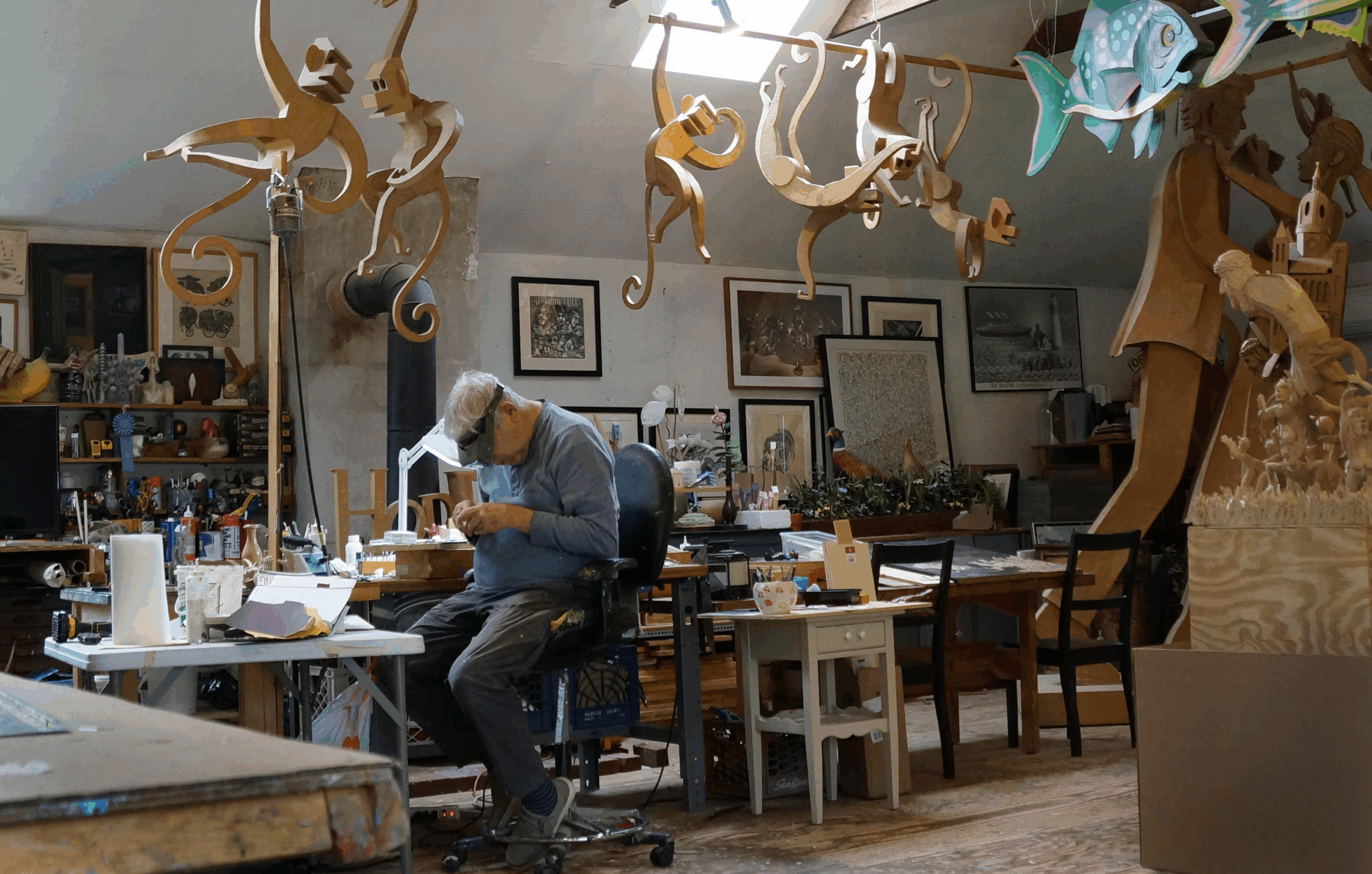Editor’s note: As we were finishing this story for the Fall 2025 issue of Prattfolio, James Grashow, known as Jimmy to his friends and loved ones, passed away at 83. His work and uplifting perspective on art making, at any age, seeing humble materials as charged with life and possibility, was an inspiration to us in creating the issue. We thank his family for the opportunity to share this story with the Pratt community.
Artist James Grashow, BFA Graphic Arts ’63; MFA Art Education ’66, was a master sculptor, capable of quickly, magically, hand-carving a subject’s likeness out of a hunk of wood, without even a photo for reference. And yet, for all his skill as a woodworker and draftsman, Grashow was pulled back throughout his career to a medium that is less expected in the realm of fine arts: corrugated cardboard. He had a special knack for working at stacks of it with his knife, cutting and painting and carving into it again until he’d produced a chain of playful monkeys, a sea- or cityscape, or even vases out of which bloom delicate architectural structures (or “houseplants,” as he called them). It wasn’t only his facility with the material that drew him to it again and again—it was the ubiquity of cardboard that made it so special. Not only is cardboard accessible to everyone in proximity to a recycling bin, but it’s almost impossible to find someone who hasn’t, at some point in their life, built something out of it.
Speaking from his studio in Redding, Connecticut, which he described as a protective space that allowed him to shut out the noise of the world, the artist was completely at ease when surrounded by his work. At age 83, Jimmy—as he’s known to his friends, whom he made very easily—exuded a sense of peace, an awareness of his own achievements as an artist, educator, father, and partner to Lesley, nicknamed Guzzy, his wife and, as he called her in an interview for this story, his “translator.”
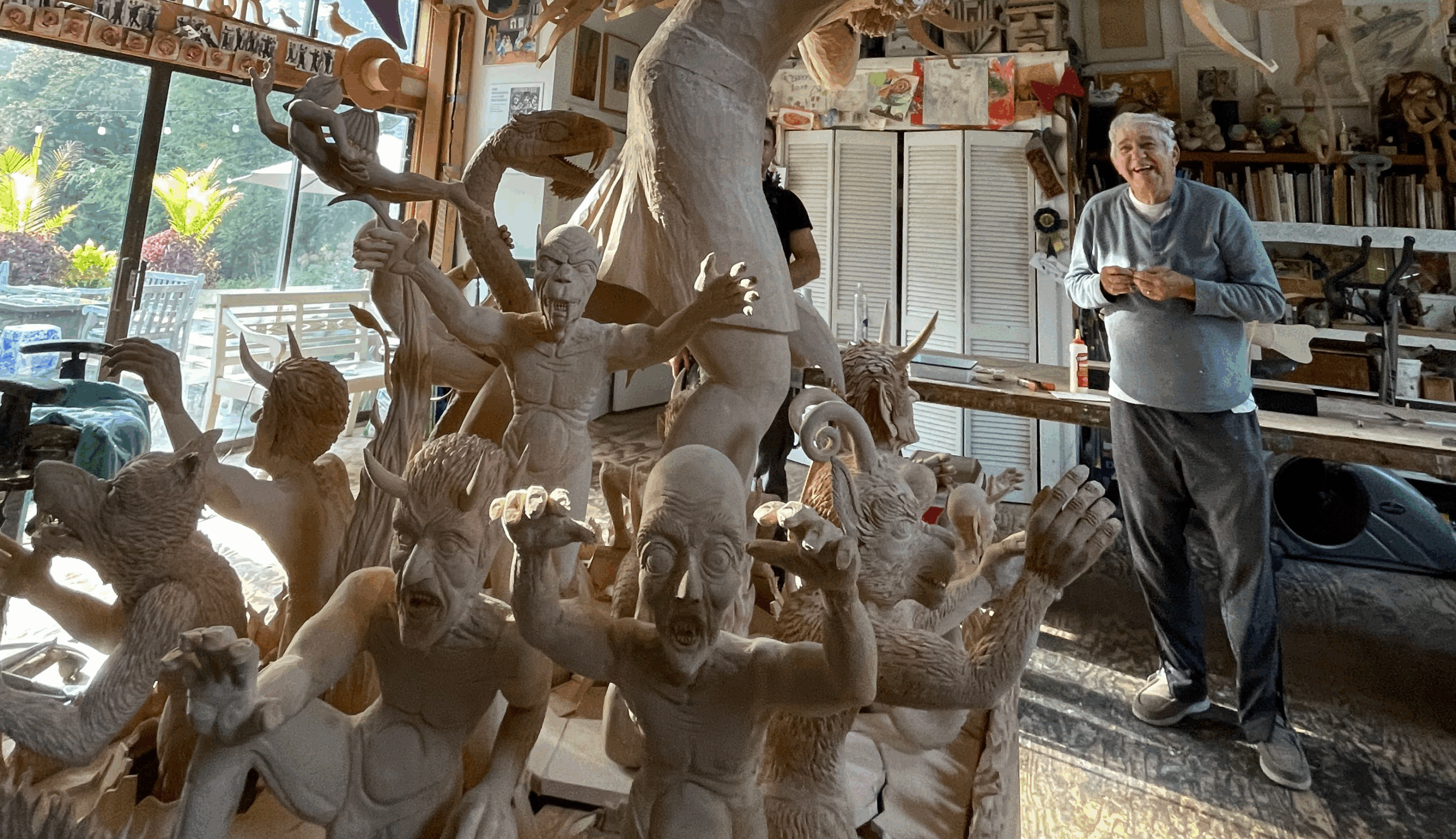
An accomplished illustrator who created the iconic cover for Jethro Tull’s 1969 album Stand Up and had a regular gig creating artwork for The New York Times throughout the 1970s and ’80s, Grashow is perhaps best known today for his vividly rendered and exceptionally playful sculptural work. Regardless of the medium and subject, his hand is immediately identifiable. His work has been exhibited all over the world and, as we see in Cindy Meehl’s new documentary about the artist, titled Jimmy & the Demons, which premiered at the Tribeca Film Festival in June, over these past few years, he’d been beginning to consider what all this work that he’d created, and all of this life that he’d lived, added up to.
It was at Pratt where he first discovered that art could be both a form of communication and a sanctuary. Growing up in Brooklyn in the 1950s, he sensed that art was his calling. He told me, “The only thing I ever could do really was draw. I have no mathematical skills, and I can’t spell.” It was at Pratt that he was able to bring his unarticulated dreams to fruition: “It was the holy grail for me. Finally, I was doing something that I absolutely loved. Pratt was everything.”
Specifically, the school and its professors introduced him to the many mediums that he would go on to master over the course of his career. Grashow said, “I think I remember every teacher who influenced me”—Steven Green, Fritz Eichenberg, Jacob Landau, Richard Lindner, and painter George McNeil—and he described the late Richard Bove as an “unbelievable teacher.” Bove later asked Grashow to take over his class, which he did and continued to teach at Pratt for more than 10 years.
“I have come to feel that an artist’s true identity is not found in the images he makes but in the medium he chooses.”
Before that, after graduating with his MFA in art education in 1965 and spending a year in Florence on a Fulbright scholarship, Grashow became a working artist, supplementing his commercial and gallery work with teaching. He began to teach at Pratt, one day a week, in the late ’60s, where he brought an infectious enthusiasm, wit, and love of materiality to the classroom. As he put it, “My class was more about creativity and how to conceive, rather than how to draw. My theory was that once you understood space, you could draw anything. How do you put a line to paper? What does it mean to create a form?”
Grashow thought of teaching as an extension of his artistic practice. He sought to engage his students in his own fascination with the incredible possibilities of the materials themselves. He vividly recalled some of his favorite moments working with students: “At Pratt, we did anything we wanted to do. . . . We made a big Thanksgiving table and had the students draw giant plates and a turkey dinner on it. We made clothespins, and everyone had to do a drawing of their laundry, and we hung the laundry throughout the school, even over the entrance to Pratt. Every week was an adventure. Now, 50 years later, I still get notes and letters about that class.”
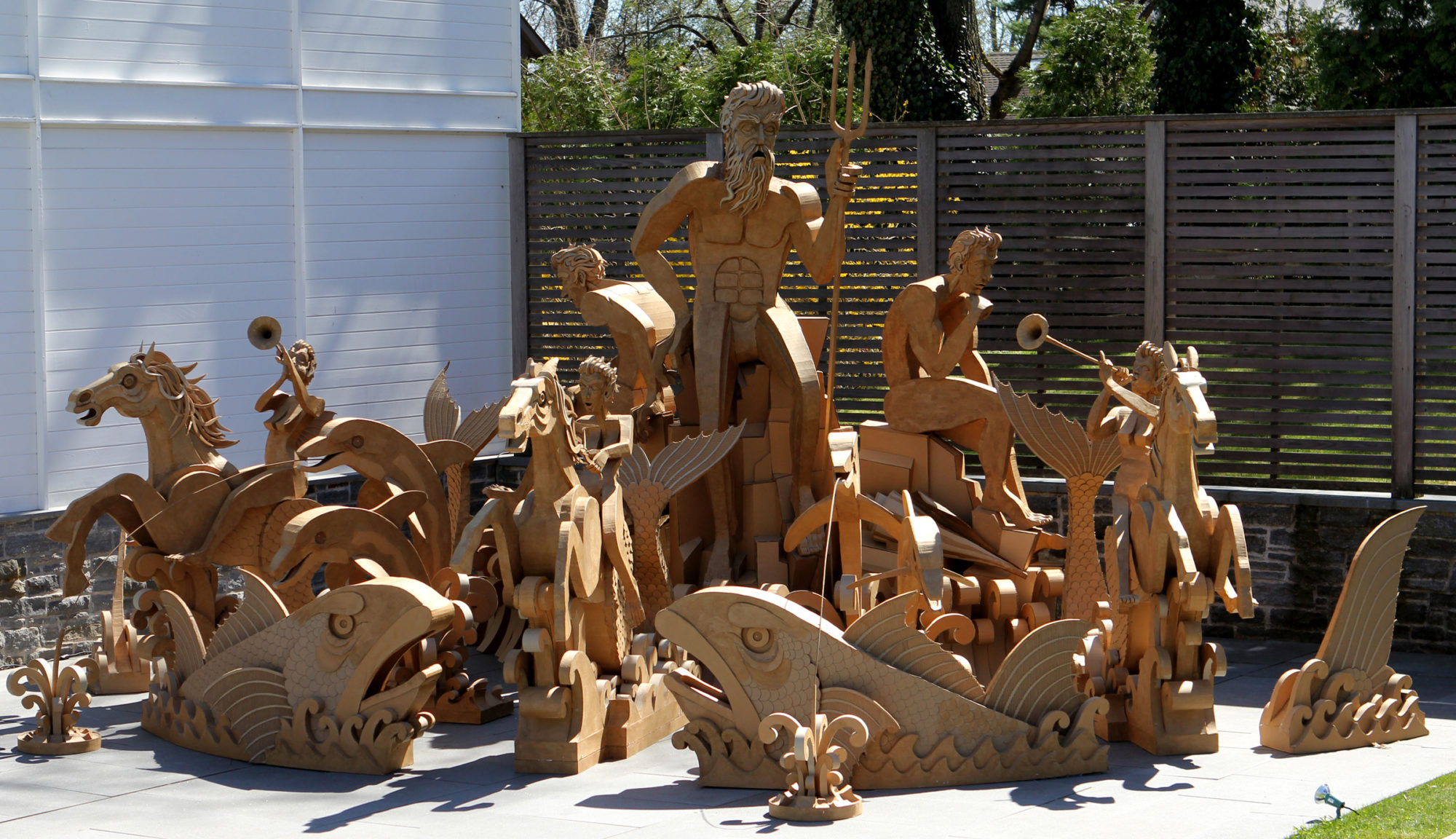
Then and throughout his career, Grashow’s teaching and his art found the extraordinary in the everyday. Which brings us back to the material that has come to define Grashow’s sculptural practice: common, run-of-the-mill cardboard. The industrial packing product has been a constant in his work, from the endlessly inventive and playful installation work from the ’70s and ’80s to his more recent large-scale project, Corrugated Fountain (2012), a detailed rendering of Bernini’s fountain that was left, by design, to crumble and collapse outside the Aldrich Contemporary Art Museum in Ridgefield, Connecticut.
“Cardboard is grateful for the opportunity to become something, and a person is grateful to be given a chance to make it.”
For the artist, the disposability of cardboard was conceptually, even spiritually, significant. As he told me, with a menagerie of cardboard creatures dangling behind him in his wonderland of a studio: “We’re dispensable; we’re disposable; we’re finite, just like cardboard. So cardboard and people become the perfect partners in a claim to eternity. Cardboard is grateful for the opportunity to become something, and a person is grateful to be given a chance to make it.”
For students of all ages, he saw cardboard as an invitation to creativity. In a New York Times story this past summer, he said it could be particularly potent for anyone who feels they’ve lost their connection with making: “Cardboard is the gate back!”
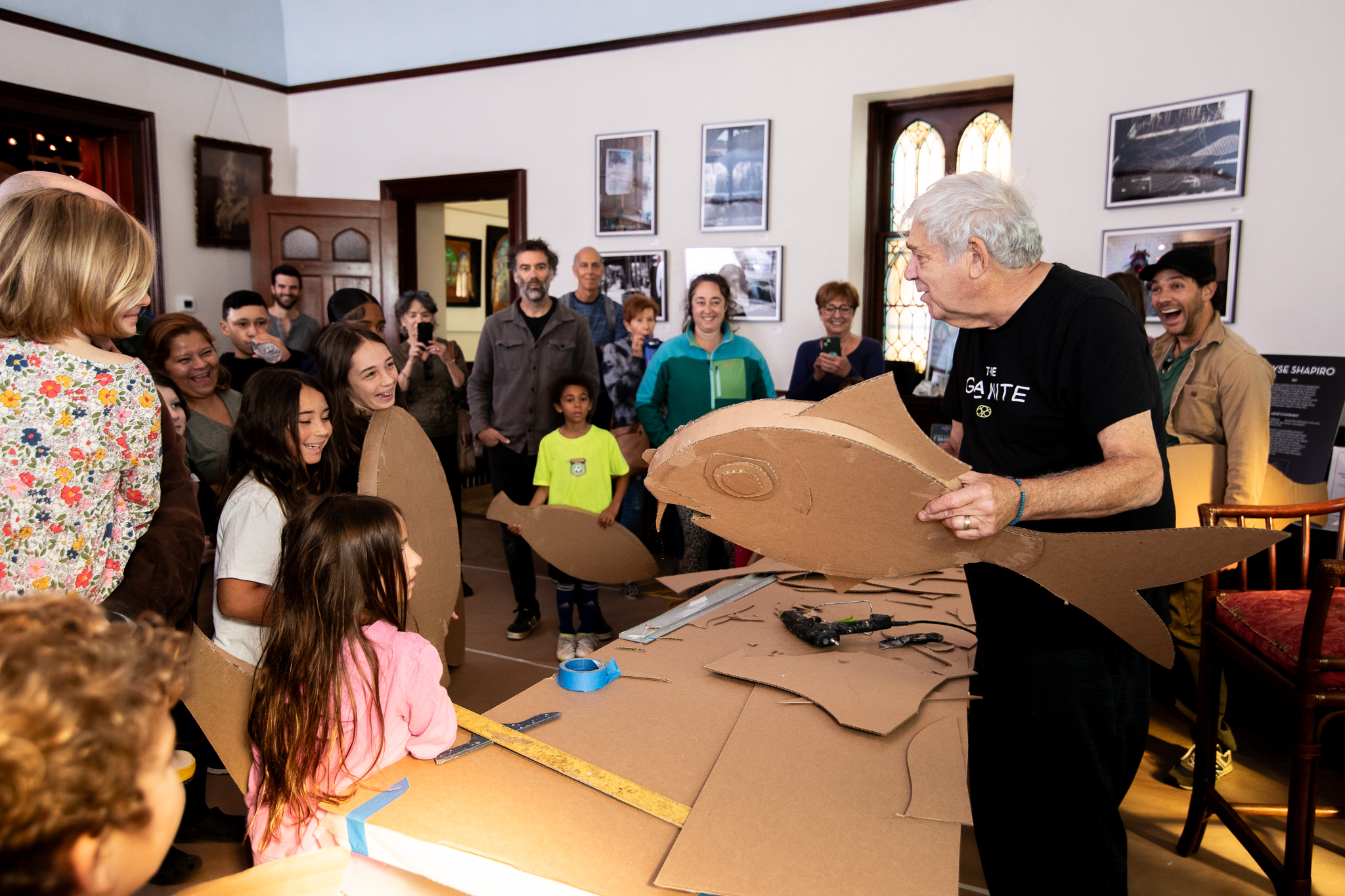
Clearly, for Grashow, it was the work itself, and his direct engagement with the raw materials of his projects, that made it all worthwhile. It’s not the product, as they say, but the process, approaching each day as another opportunity to physically interact with the world in a creative way. “When I wake up, I love to work,” he said. “Some days you wake up and you’re unbelievably physically jittery; your body wants to do something gigantic. You want to make a big machine. And then there are days when you want to do something that’s seamless, like a mantra, something slow and contemplative.”
Meehl’s film follows Grashow over the course of the four years it took him to complete The Cathedral, a hand-carved wood piece that the artist saw as a rumination on mortality, and something of a culminating project, weaving together the many formal and thematic concerns that had obsessed him over the years. The piece centers on an effigy of Christ, who, as grotesque demons grasp at his heels, hefts a magnificent church on his shoulders. The sculpture is weighty in its religious and art historical references, while bubbling over with Grashow’s signature wit.
“I have come to feel that an artist’s true identity is not found in the images he makes but in the medium he chooses,” Grashow reflected, in a favorite quote shared by Lesley. Of wood, he said, “I love the contemplative process required by a woodcut; its detail-by-detail evolution toward finish. A smooth and sensual piece of wood and the limitless possibilities it provides seem to touch the heart of what I am.”
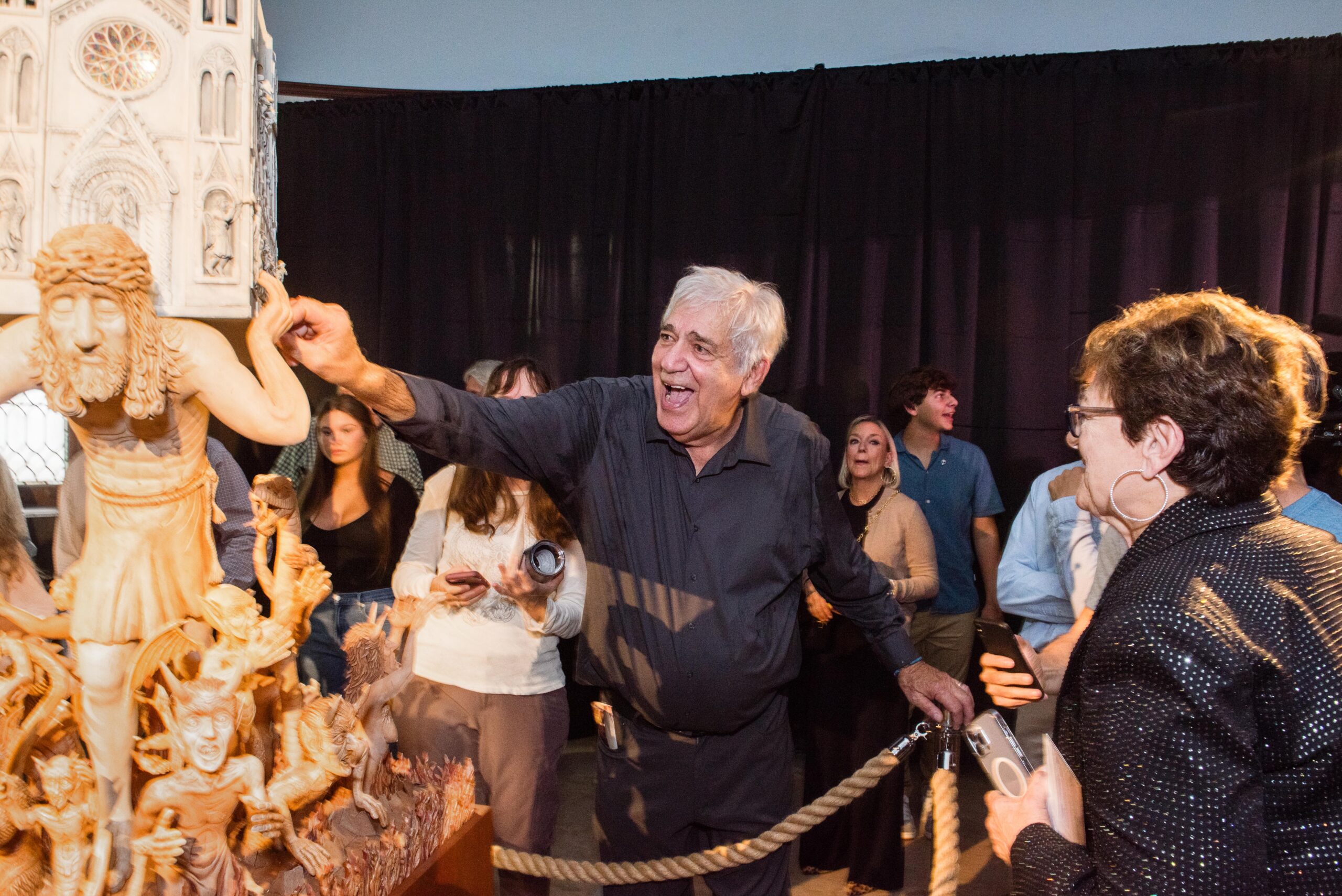
Though he was raised Jewish, The Cathedral emerged fully formed in his imagination not as an illustration of religious dogma, but as a remarkably straightforward expression of the struggle we all feel to overcome our demons. In Grashow’s perspective, that happens through the practice of the art, and the miracle of creation.
Art, for Grashow, was a refuge, a place in which those demons could be transubstantiated into laughter and joy through process and form. As he described it, there was a profound connection between his approach to art making and his approach to teaching, both of which were honed during his time at Pratt: “It’s being in the moment. All time collapses. You’re 100 percent there. If you’re an artist, that’s where you want to be. Where time and everything disappears, and the only thing you feel is the chalk and charcoal. Your body lives to be there. When you teach, that’s where you want everybody to be. It’s like everybody is an electric terminal, and you can light one up, and then that person lights the next one. The idea is to light up the whole room.”
